This post may contain affiliate links. Please see our disclosure policy.
Seedless black raspberry jelly captures the essence of fresh summer black raspberries right in your pantry for year-round eating, and the only thing missing is those pesky seeds. Trust me, it’s much better that way!
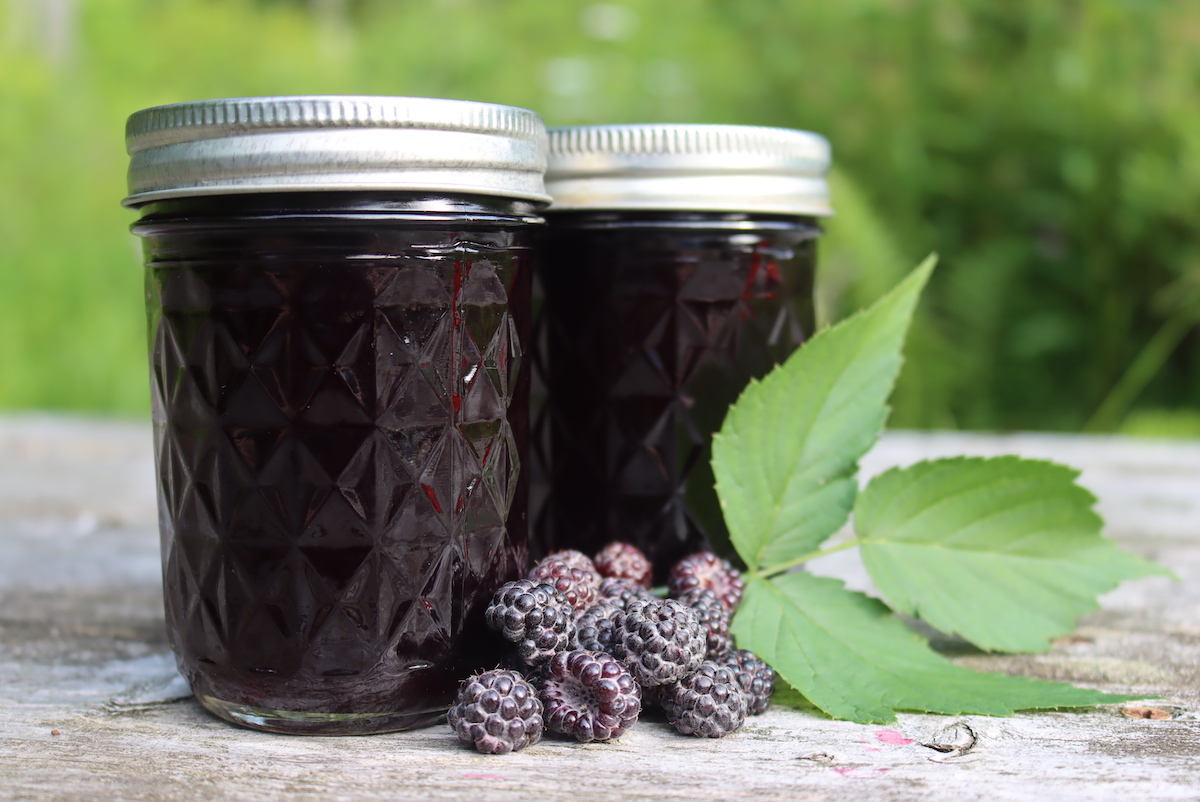
We’re blessed with an abundance of wild black raspberries each summer, and it seems like there’s more each year. The first few years I made black raspberry jam and I slowly harvested them over several days until I had enough for a batch.
These days, it seems like I could pick a bucket of these beautiful fruits each day, and truth be told, I’m happier eating them without the seeds. I don’t mind blackberry seeds in my homemade blackberry jam, and I think both raspberry jam and raspberry jelly are spectacular.
While flavorful, black raspberries are extra seedy, and they seem to have a greater proportion of seeds than other berries. Seedless black raspberry jelly is definitely the way to go when you harvest a bumper crop of black raspberries.
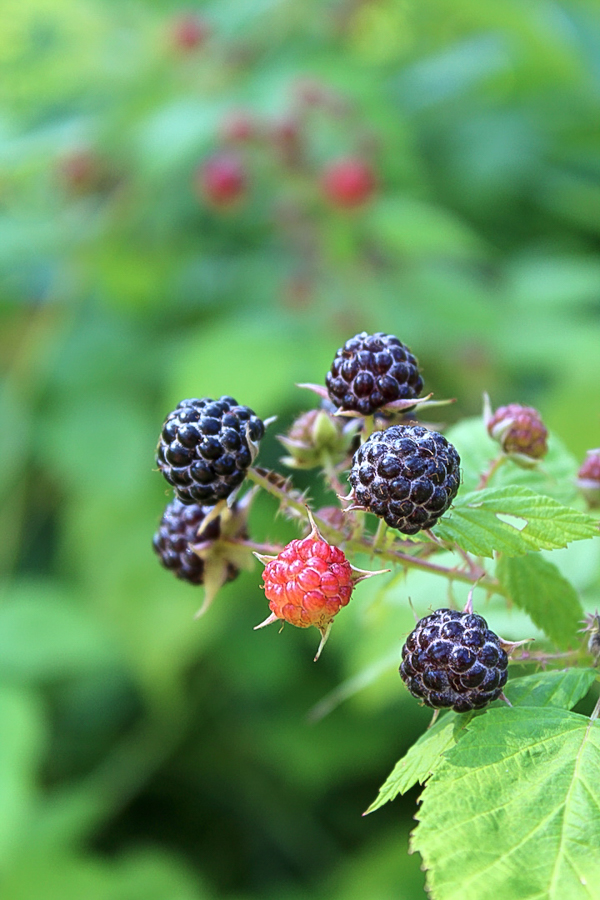
Harvesting Fruit for Black Raspberry Jelly
The first step in making black raspberry jelly is finding fresh black raspberries. Generally, when making berry jelly, it’s helpful to harvest a proportion of the fruit a tiny bit underripe.
Underripe berries have more natural pectin in them than fully ripe berries. I’m not saying totally unripe, I just mean berries that are not quite jet black yet. Harvesting about 1/4 to 1/3 of the berries slightly underripe, with just a slightly brighter color than the jet black fully ripe ones, will ensure a good set on the jelly.
This is more important with other types of berries, and black raspberries happen to be particularly pectin-rich. If you happen to have fresh black raspberries from the farmer’s market that are fully ripe you’ll likely be just fine, but opt for some underripe if you can.
In our yard, I generally have my pick of berries (and the birds do too), so there are plenty of both fully ripe and slightly underripe berries to go around.
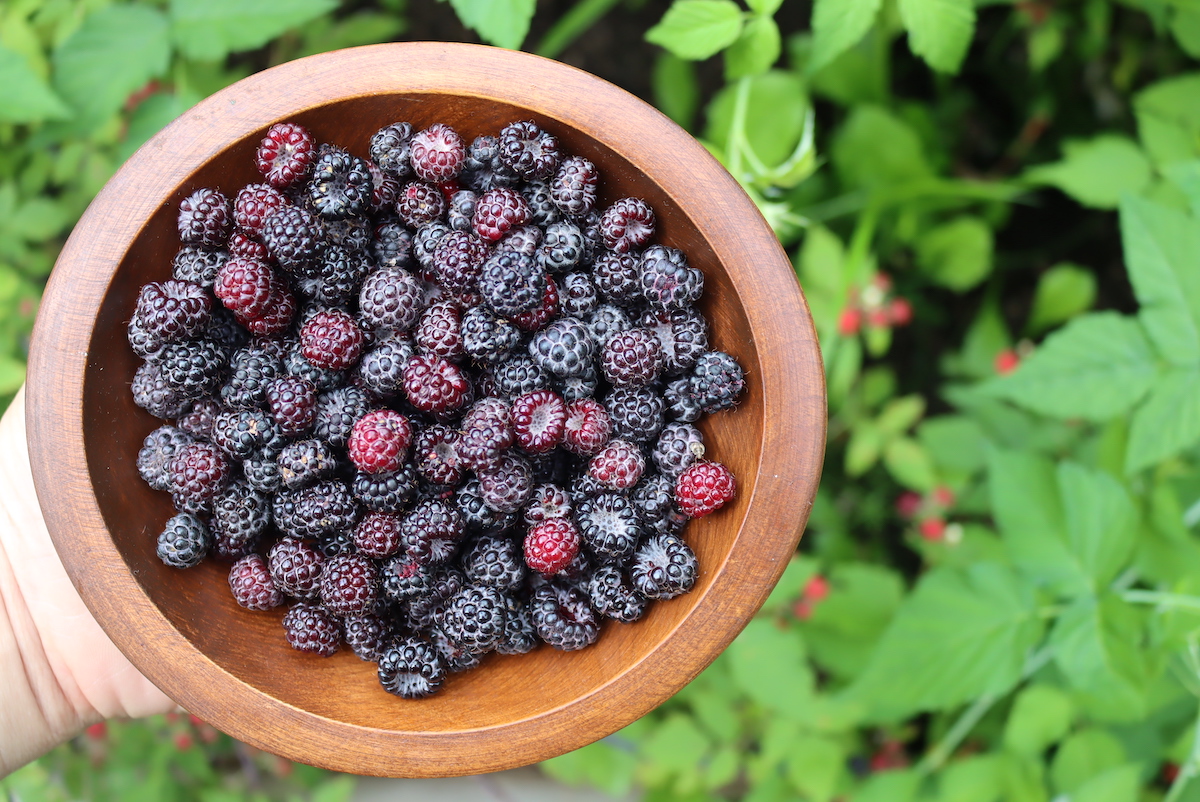
How to Make Black Raspberry Jelly
Start by juicing the black raspberries by cooking them with a small amount of water. I’d suggest using about 1 cup of water per quart of fruit (or 1/4 cup water per cup of fruit).
You’ll need a bit less than a quart of fruit (3 to 4 cups) of fruit for every cup of juice. Generally, a “batch” of jelly is made with 4 cups of juice, so you’ll want 3-4 quarts of fruit.
(That’s considerably more fruit per cup of juice than when you’re making blackberry jelly, as black raspberries have a lot less juice. The process and recipe are otherwise quite similar.)
Simmer the juice with a bit of water until the fruit have completely fallen apart, and then strain the mixture through a jelly strainer or a double layer of dampened cheesecloth. Measure the resulting juice.
For every cup of juice, add 3/4 cup of sugar. If you have 4 cups of juice, you’ll want to add 3 cups of sugar.
Bring the juice and sugar to a boil in a jelly pot and cook, stirring continuously, until it reaches gel stage (220 degrees F on an instant-read thermometer). Lacking a thermometer, you can test for set on a plate that’s been chilled in the freezer. When set, it should solidify quickly on the cool plate and then wrinkle back when pressed with a spoon.
It should take about 8 to 10 minutes to set properly but could take longer as there’s always variation in fruit and juice.
Once ready, pour the finished jelly into jars leaving 1/4 inch headspace.
Canning Black Raspberry Jelly
As always, actually canning jelly is optional, and you could always store this in the refrigerator for up to 3 weeks, or freezer for up to 6 months.
Personally, though, I prefer canning because it’s quick and easy, and it ensures I can enjoy the taste of summer black raspberries year-round. That’s extra nice during our long Vermont winter.
If you’re not familiar with canning, I’d suggest reading my beginner’s guide to water bath canning before getting started.
Fill the jars, either half-pints or pints, leaving 1/4 inch headspace. Load them into a pre-heated water bath canner and process for 10 minutes (or 15 minutes if above 6,000 feet in elevation).
Remove the jars to cool on a towel on the counter, and leave them undisturbed for 24 hours to seal. Check the seals and store any unsealed jars in the refrigerator for immediate use.
Properly canned and sealed jars will maintain peak quality on the pantry shelf for 12-18 months.
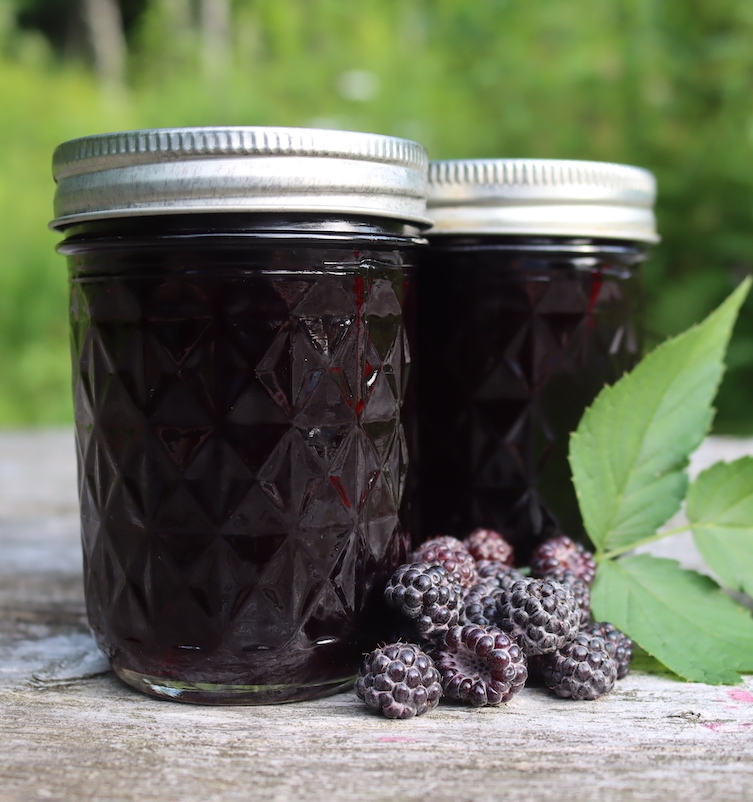
Black Raspberry Recipes
Looking for more ways to use black raspberries?

Black Raspberry Jelly (Seedless)
Ingredients
- 4 cups black raspberry juice, from 3-4 quarts black raspberries
- 3 cups sugar
Instructions
Extracting Juice
- Start by placing 3 to 4 quarts of black raspberries in a large saucepan. Add about 1/4 cup of water per cup of fruit—roughly 1 cup of water total.
- Bring the mixture to a simmer over medium heat and cook for 10 to 15 minutes, stirring occasionally, until the berries completely break down and release their juice.
- Pour the mixture through a jelly bag or a fine-mesh strainer lined with cheesecloth. Let it drain for several hours or overnight to extract as much juice as possible without squeezing (which can make the jelly cloudy).
- Measure out 4 cups of juice for the jelly recipe. Excess juice can be frozen or used for another batch.
Making the Jelly
- For every cup of juice, add 3/4 cup of sugar. This recipe uses 4 cups juice and 3 cups sugar, but it can be scaled up or down depending on your yield. Avoid using more than 8 cups of juice per batch to ensure proper gelling.
- If canning, prepare a water bath canner.
- Place the juice and sugar into a saucepan and bring to a hard boil. Cook over medium-high heat, stirring frequently, until the jelly reaches the gel stage (220°F on an instant-read thermometer). You can also test for set by placing a spoonful on a chilled plate and checking for wrinkles when pushed. This should take about 8 to 10 minutes, though times may vary.
- Once gel stage is reached, ladle the jelly into prepared jars, leaving 1/4 inch headspace.
Canning Blackberry Jelly (optional)
- If canning, process the jars for 10 minutes in a water bath canner, or 15 minutes if you’re above 6,000 feet in elevation. Remove jars and let them cool undisturbed on a towel for 12 to 24 hours. Check seals before storing.
- Properly canned and sealed jars will keep for 12 to 18 months in a cool, dark pantry. If not canned, store the jelly in the refrigerator and use within a few weeks.
Notes
Nutrition
Nutrition information is automatically calculated, so should only be used as an approximation.
Easy Jelly Recipes
Need a few more silky-smooth homemade jellies for your pantry shelf?
Summer Canning Recipes
Putting up more than just jelly this season?
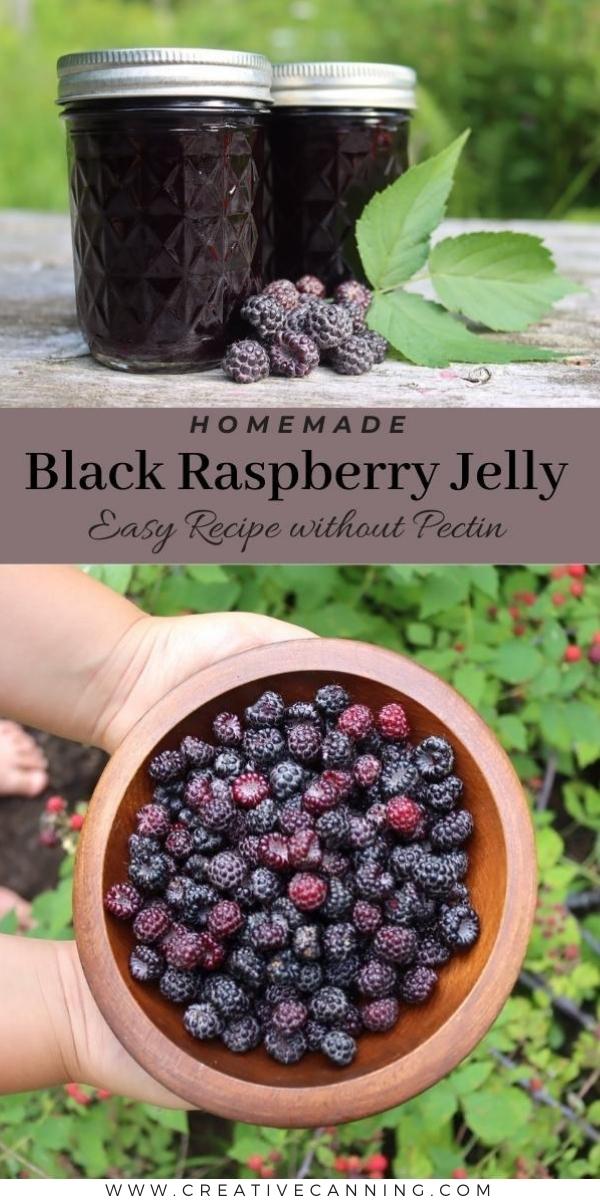
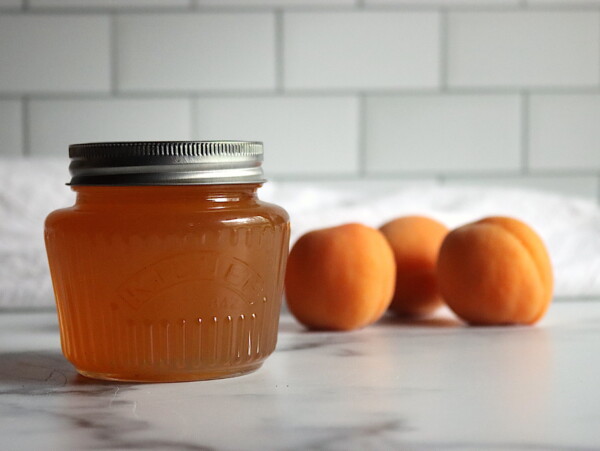
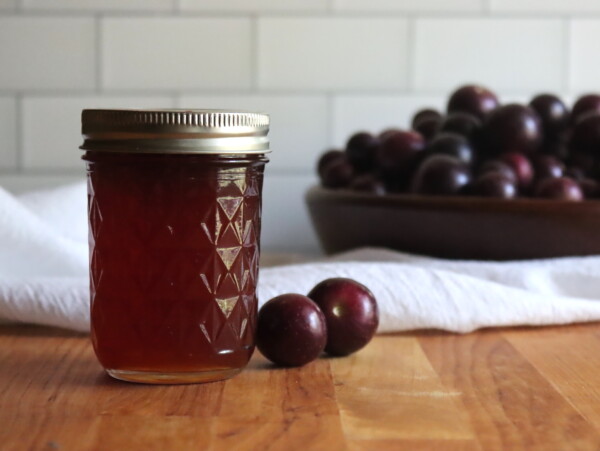
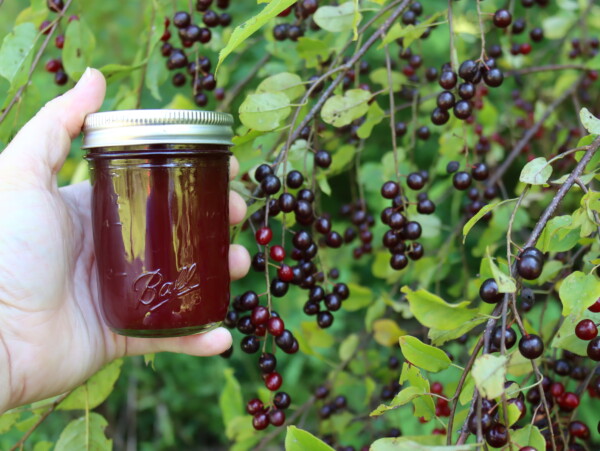

There’s no mention of de-seeding!
For this recipe, you’re extracting the juice and then turning it into jelly. When you extract the juice, you put it through a jelly bag with takes out the seeds.
“Simmer the juice with a bit of water until the fruit have completely fallen apart, and then strain the mixture through a jelly strainer or a double layer of dampened cheesecloth. Measure the resulting juice.”
Very helpful, thank you! I did not realize some of this, so next time, if I add sugar to a partial harvest as I go, I will use the no-pectin 220 degrees soft gel method you describe; otherwise maybe I will freeze the berries (without sugar added) until I have enough for a batch, but then be sure to get the ratio of fruit to sugar for a pectin set and follow the order of adding pectin, sugar, etc. Thank you so much for taking the time to address my questions! Of course for now, it is delicious in a sparkling water or tea!
I am wondering if you have advice for me. I grew up picking these for my grandmother, who would make amazing seedless jelly every year. Last year I noticed some canes on our property so this year, built a rough trellis with some tree branches; they produced flowers and berries and I was delighted. Reading your original (jam with seeds) recipe, I followed your advice to put 1/2 cup sugar in 1 cup berries to set aside to preserve and draw out the juice, while I went out there night after night to scour the canes for berries, as there was not nearly enough in one or two pickings to use for a recipe. Once I had about 4 cups of berries (to which 2 cups total sugar had been added), there were no more berries left; birds got the rest. I see recipes with lemon juice added, but I really didn’t want that to interfere with the flavor that I grew up loving. I had already added sugar to the berries, so I started from there, following your seedless recipe (posted here) for jelly, by putting them in a pot and simmering. I strained through cheesecloths and got about 2.25 cups of juice total, which already included sugar. Though these apparently contain a lot of pectin, and they must be acidic enough not to need lemon juice in most of the recipes that circulate, I was reluctant to let it boil until it hit the soft set (I’d done this with apple scrap jelly last year and it just feels discouraging (when you don’t have a big yield); it seems like you’re boiling and boiling and reducing the volume of the liquid by so much! I was afraid I would only have a single 8 oz jar of jelly in the end. So instead, I found a recipe for black raspberry jelly that includes pectin. They had 1 box pectin (6 tbls) to 10 cups berries to 5 cups sugar. So I figured with my 4 cups berries to 2 cups sugar, maybe 3 tbls fruit pectin would be sufficient. I brought to a hard boil and boiled one minute. Then processed 10 minutes. The lids popped but 24 hours later, they are liquid! I’ve made syrup. Which isn’t a total loss, we can use it on ice cream or in sparkling water. But do you think there is a way I can re-process this? I just don’t see how, considering the amount of pectin used, and the amount of pectin naturally occurring, it didn’t set… I make other jams and jellies every year and this hasn’t happened to me in quite a while, so I am puzzled. Is it possible they lacked the acidity, and needed a little lemon after all? Or greater quantity of sugar than the ratio I’d used?
Great question. So a couple of things here:
-Some types of pectin won’t set if they’re not added before the sugar. If you add the sugar before you add the pectin, it can’t dissolve properly and binds rather that incorporating, resulting in a syrup.
-Most types of “regular” pectin require a 1:1 ratio of fruit to sugar, so unless you used a low sugar pectin, it’s not likely to set.
-To get a no pectin jelly to set, you need to cook it to 220F, and that is going to need a longer cook time than you get when you’re using boxed pectin.
There are a couple ways you can save it (beyond using it as syrup). You can re-cook it with pomona’s pectin, which has you mix a bit of sugar into the pectin so they’re added at the same time. Follow the instructions on the box, and be sure to use the calcium water. It works a bit differently than regular boxed pectin. In general, you use 2 tsp pectin and 2 tsp calcium water with 4 to 5 cups liquid (or syrup in this case).
You can also try using liquid pectin, which has you add the pectin after the sugar. With that though, you need a ratio of 4 cups liquid to 7 cups sugar to get a set, with 2 pouches pectin. That’s A LOT of sugar, and it gives a loose set in the best of cases. But it does work for re-cooking jellies.
Hope this helps!
hello, can you please inform me of what the serving size is for the black raspberry jelly? I don’t see it in the nutritional information at the end of the recipe. Thanks much. Made this yesterday and it turned out perfect. Thanks for all your sharing you do. 🙂
I updated the recipe card with serving size. It’s now set to 1 Tbsp, which is about what I use for 1 piece of toast.
This has been a fun recipe to try. I have lots of wild black raspberries so it’s nice to be able to use them. I’m boiling the juice and sugar right now but it doesn’t seem as if the jelly is setting. Should I go buy some pectin or will it set once cooled in the jars? It did reach 220 degrees as well.
This one can take a while to set and often starts off looking like syrup when it goes into the jars. It’ll usually set within 48 hours, but if not, here’s a troubleshooting guide for jellies that don’t set: https://creativecanning.com/troubleshooting-jelly-set/
I made the black raspberry jelly last night, but I don’t think I let it boil at the 220 degree mark long enough as it is not set. It has been about 12 hours. Everything I’ve read says it could take 24-48 hours to fully set, but when I check it, it’s WAY runny. If after the 24-48 hour mark it’s still runny, can I re-boil to reach the 220 mark and keep it boiling for longer? After it reaches the 220 degree mark, how long should I let it boil?
Yes, you can definitely pour it back out and re-cook it, making sure you get to the 220 mark before you put it in the jars. The end of this troubleshooting guide has help on re-cooking jellies to ensure set, and usually adding a bit of lemon juice when you re-cook them helps them set as well: https://creativecanning.com/troubleshooting-jelly-set/
The end product flavor is superb however the consistency is more sauce like. I brought the temp(with a top of the line instant read thermometer) to 220 and had under ripe berries in the mix. Maybe a hard boil before taking it off the heat? Next time I think I will stick to the freezer plate test.
Can you make the low sugar version of this using lemon juice instead of adding surejell low sugar pectin? Or will it not set. Also could a person allow some seeds into this or will that throw the recipe off?
This, unfortunately, won’t set as a low sugar recipe without adding a low sugar pectin. You can use sure jell low sugar or pomona’s pectin, both give great results. Lemon juice adds pectin…but not enough to get a set on this one with low sugar. As to the seeds, you don’t have to remove any of the seeds if you don’t want to. If you want to keep the seeds in there, and the fruit pulp, it’s much easier to get a set that way and you may be able to get it to set as a low sugar black raspberry jam instead of jelly without pectin. Here’s a place to start on black raspberry jam: https://practicalselfreliance.com/black-raspberry-jam/
Can you use frozen berries in this recipe? I’m afraid the berries I’ve already picked will go bad before the rest ripen.
Freezing denatures some of the pectin in the fruit, and black raspberries may not set properly without pectin if frozen first. I haven’t tested this recipe with frozen fruit, it may or may not set. You can try it if you like, it might work. But, I know you can set it just fine using pectin. Use my cherry jelly recipe, and replace the extracted juice of cherries with the black raspberry juice.
I’m surprised this thickens without the seeds or pectin! I had always heard the seeds have the pectin so I didn’t realize you could make it without pectin and the seeds ☺️good to know
Yup, it thickens just fine, provided there’s enough sugar. Black raspberries have quite a bit of natural pectin, and it sets nicely. (That’s also true of blackberries and raspberries too, I set my seedless jellies with all of those without added pectin.)